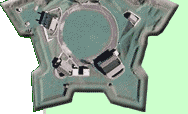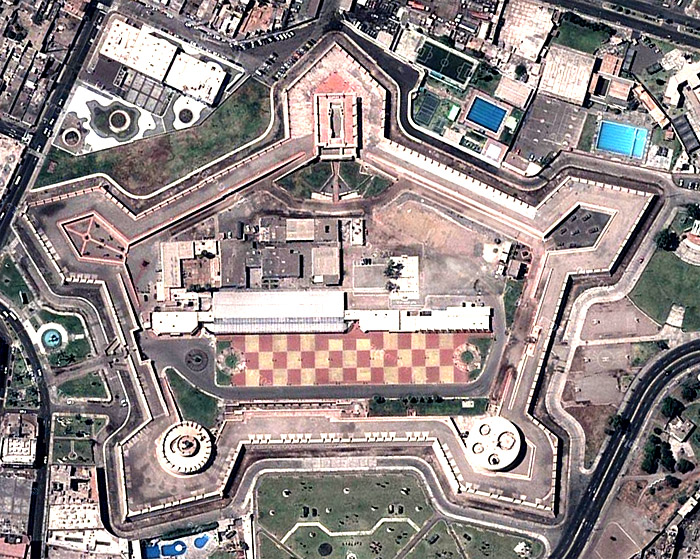
 |
 |
Fuerte del Real Felipe Callao, Peru |
 |
 |
 |
 |
 |
||
 |
Spanish Conquistador Francisco Pizarro (1471-1541) led a force that defeated Inca Emperor Atahualpa and took over his empire in 1532: Ten years later, Spain established the Viceroyality of Peru, which included most of its South American conquests. Pizarro was named the governor of the lands he had conquered, and he founded his capitol city on January 18, 1535 as Ciudad de los Reyes, or City of Kings: This would become Peru's capitol, Lima. One of the reasons Pizarro chose the location he did for Los Reyes was that it was only about 10 miles from a lovely natural port at what is now Callao: Spanish interest in South America was pretty comprehensively directed towards finding cool stuff and shipping it back to Spain for the king to wallow in, so seeking out natural ports was their number one priority...well, maybe it was their number two priority, number one being to conquer things. The port eventually got its name through Spanish sailors' slang for the word pebble (one imagines a pebble beach there), which was Callao. As time went on homes and businesses sprang up to house and cater to the constant stream of Spanish sailors, and by 1555 Callao had become a town. Fearing mini-conquests by pirates and corsairs, Lima was fortified with walls from 1684 to 1687, which was great for Lima but not so good for Callao, an even more attractive pirate destination, being conveniently situated right there on the sea. A series of violent attacks on Callao, such as one in 1579 by English privateer/pirate Sir Francis Drake (1540-1596) and a Dutch raid in 1624, led the town's inhabitants to construct a defensive wall in the mid-17th century. A massive earthquake, triggering an even massiver tidal wave, destroyed Callao in 1746. The city wall, in addition to all of the town's buildings and 4800 of Callao's 5000 inhabitants, were washed into the sea. Whatever the state of the town, the Spanish still needed its valuable port, so the Fuerte del Real Felipe was constructed at Callao from 1746 to 1773. The Fuerte was named for Spanish King Philip V (1683-1746), and was the largest single structure built by Spain in South America. The Fuerte del Real Felipe sat, in a benevolently menacing fashion, peacefully until the beginning of the 19th century. Riches from Spain's South American holdings were running out by this point, forcing the Spanish crown to increase taxes on its subjects in the region, lest it be without a continual flow of unearned gold and silver. This predictably pissed off South Americans who'd had about enough of being subjected to Spanish colonialism for 250 years anyway, and a series of independence movements took hold. Peru remained a royal stronghold through much of the surrounding turmoil. In expectation of trouble, a weapons warehouse and cistern, intended to supply a garrison of 2000 through a four-month siege, were built in the Fuerte in 1806. On January 21 1816, a fleet led by Admiral William Brown (1777-1857), the Irish-born, American-immigrated, British-Navy-pressed admiral of the Argentinian Navy, sailed into Callao, captured some Spanish ships and ineffectually bombarded the town. Guns from the heroic Fuerte del Real Felipe drove them off before major damage was done. On January 16 1819, another busybody Englishman, Admiral Lord Thomas Cochrane (1775-1860), led the Chilean Navy towards Callao as one of his many raids along Peru's coast: Again, the guns of the Fuerte kept Cochrane and his seaborne pests at bay, driving them from the port. Argentinian Jose de San Martin (1778-1850) led military campaigns that led Argentina, Chile, and finally Peru to independence from Spain by 1821. The Fuerte del Real Felipe was held by the Spanish until September 19 1821, when commander Jose de La Mar surrendered the fort to the independence movement, his garrison suffering from disease and lack of food. San Martin renamed the Fuerte as the Castillo de le Independencia, which of course translates as the Castle of Independence, which probably sounded nice at the time (but is lame). Spain recaptured the Fuerte in 1824 and held it until 1826. The Castle of Independence then served as a political prison from 1826 until 1833. A bewildering series of events relating to the vagaries of South American democracy swirled around the Fuerte for the next several decades, including one newly-elected president barricading himself within the fort, expecting attack by the president he had ousted. The War of the Pacific (1879-1884), a primarily naval war that pitted Chile against a defensive alliance of Peru and Bolivia over rights to mineral-rich territory, saw the Fuerte's last military action. A major Chilean landing attempt at Callao was thwarted by the Castle, though enough Chilean troops made it ashore to destroy San Rafael and San Miguel, two smaller fortifications in the city. After the war, the Castle was used as a customs facility, Callao being Peru's primary port. The region enjoyed a financial upswing thanks to the "Guano boom," which is a weird descriptive term for what would result in a very smelly aftermath. In 1925 Peruvian president Augusto Leguia (1863-1932) thankfully restored the Castle's original name, plus initiated a restoration project for the Fuerte's physical being as well. The fort was named a national monument on May 19 1952, and became the location of the official Museum of the Peruvian Army. Further restoration began in 2007, and today the Fuerte del Real Felipe is one of Peru's leading tourist attractions. |
 |
 |
||
|
|
|||||||
Info Source 1 Info Source 2
Info Source 3
Info Source 4 Info Source 5 Info Source 6 Info Source 7 Info Source 8 Info Source 9 Info Source 10 Info Source 11 Info Source 12 Info Source 13 Info Source 14 Info Source 15 Thanks to Google Maps for the image! ©2010 starforts.com |
 |